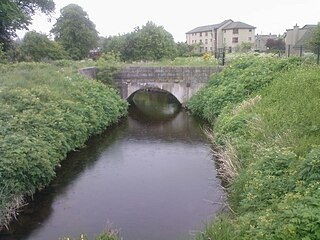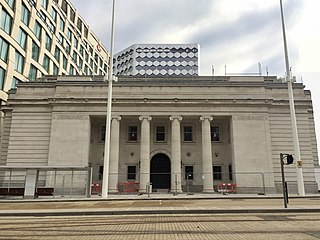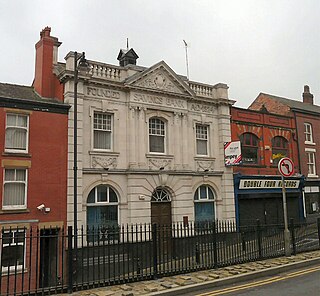Related Research Articles

Airdrie Savings Bank was a small commercial bank operation in the Lanarkshire area of Scotland. It ran three branches throughout the area, with its head office in Airdrie at the time of the announcement of its closure. Total assets of the bank at 31 October 2013 were £158 million with a reported loss of £267,000. In January 2017, the bank announced it would begin closure proceedings on 28 April of that year.

The Trustee Savings Bank (TSB) was a British financial institution that operated between 1810 and 1995 when it was merged with Lloyds Bank. Trustee savings banks originated to accept savings deposits from those with moderate means. Their shares were not traded on the stock market but, unlike mutually held building societies, depositors had no voting rights; nor did they have the power to direct the financial and managerial goals of the organisation. Directors were appointed as trustees on a voluntary basis. The first trustee savings bank was established by Rev. Henry Duncan of Ruthwell in Dumfriesshire for his poorest parishioners in 1810, with its sole purpose being to serve the local people in the community. Between 1970 and 1985, the various trustee savings banks in the United Kingdom were amalgamated into a single institution named TSB Group plc, which was floated on the London Stock Exchange. In 1995, the TSB merged with Lloyds Bank to form Lloyds TSB, at that point the largest bank in the UK by market share and the second-largest by market capitalisation.

Kintore is a town and former royal burgh near Inverurie in Aberdeenshire, Scotland, now bypassed by the A96 road between Aberdeen and Inverness. It is situated on the banks of the River Don.

The Aberdeenshire Canal was a waterway in Aberdeenshire, Scotland, designed by John Rennie, which ran from the port of Aberdeen to Port Elphinstone, Inverurie. It was originally planned to reach Monymusk, but had been truncated by the time an Act of Parliament was obtained in 1796. Construction was hampered by a lack of finance, and some local opposition, but it opened in 1805. Some of the workmanship was sub-standard, and several of the locks failed soon afterwards, but they were reconstructed, and reopened in late 1806.

Insch is a village in the Garioch, Aberdeenshire, Scotland. It is located approximately 28 miles (45 km) from the city of Aberdeen.
WestAberdeenshire was a Scottish county constituency of the House of Commons of the Parliament of the United Kingdom from 1868 to 1918 and from 1950 to 1983. It elected one Member of Parliament (MP) by the first past the post system of election.

Garioch is one of six committee areas in Aberdeenshire, Scotland. It has a population of 46,254, which gives it the largest population of Aberdeenshire's six committee areas. The Garioch consists primarily of the district drained by the River Ury and its tributaries the Shevock and the Gadie Burn.

New Deer is a settlement in Aberdeenshire, North East Scotland, which lies in the valley of Deer. It is located at the junction of several roads crossing through the Howe of Buchan. It was founded after monks from Deer Abbey, Old Deer, built a chapel at Auchreddie, which translates as "field of the bog myrtle", and lies clustered on both sides of the slope of a tributary of South Ugie Water. Around 1507 the register of Deer Abbey lists its lands in the "new paroche of Deir". The name Auchreddie has dropped in significance over the years; however, the southern end of the village is still known by this name.
Aberdeen Crossrail is a proposed railway development in Scotland, first proposed within the 2003 Scottish Strategic Rail Study. It is supported by Nestrans, the north-east of Scotland's voluntary regional transport partnership.

The Birmingham Municipal Bank was a savings bank in the city of Birmingham, England. It was created as the Birmingham Corporation Savings Bank by a 1916 Act of Parliament on a temporary basis and replaced by the Birmingham Municipal Bank in 1919. In 1976 it converted into a trustee savings bank.

The Freedman's Saving and Trust Company, known as the Freedman's Savings Bank, was a private savings bank chartered by the U.S. Congress on March 3, 1865, to collect deposits from the newly emancipated communities. The bank opened 37 branches across 17 states and Washington DC within 7 years and collected funds from over 67,000 depositors. At the height of its success, the Freedman's Savings Bank held assets worth more than $3.7 million in 1872 dollars, which translates to approximately $80 million in 2021.

Inveramsay railway station was a railway station in the parish of Chapel of Garioch, near the Mill of Inveramsay, Aberdeenshire. It served the sparsely populated rural area, but was mainly an interchange for the Macduff and Banff branch lines.
Formed in 1836, the Edinburgh Savings Bank was successor to the Edinburgh Bank for Savings, which dated back to 1814. Although formed after the Ruthwell Savings Bank, the Edinburgh provided the model for future savings banks. By the end of World War two, it was second in size only to the Glasgow Savings Bank. In 1975, Edinburgh merged with three other Scottish savings banks to form an enlarged South of Scotland TSB.
The Glasgow Savings Bank, formed in 1836, had become the largest savings banks in Scotland by the mid-1850s and the largest in the country by 1870. When the trustee savings banks were reorganised into regional banks in 1975 Glasgow became the core of the West of Scotland TSB.

Stockport Savings Bank LLC is a retail bank that was established in 1824 in Stockport, then in Cheshire. It was run on a conservative basis but remained independent until 1975 when it became part of TSB North West Central, following the Page Committee’s recommendation that the TSBs be grouped into larger regional entities.
The Sheffield Savings Bank was formed in Sheffield Yorkshire in 1819. For much of its early years it was run conservatively, briefly experimenting with local branches in the 1850s. In the twentieth century, branches were reintroduced, both in the city and outlying towns. By 1944 it was twelfth nationally by size of funds. In 1976, the Bank merged to form part of TSB Yorkshire & Lincoln.
The Perth Savings Bank was established in Perth, Scotland, in 1815. In 1975, it merged to form part of the Trustee Savings Bank of Tayside and Central Scotland.
The West Midland Savings Bank had its roots in Shrewsbury, Shropshire and the merger of its two town banks in 1839 to become the Salop County and Abbey Savings Bank. It remained one of many small savings banks in the Border Counties until the early twentieth century when it led a series of amalgamations. In recognition of its wider coverage, it became the West Midlands TSB in 1937. In 1975 it merged to form the TSB of Wales and Border Counties.
The Liverpool Savings Bank was a bank founded in 1815 in Liverpool, United Kingdom. By 1956, it had grown to be the fourth largest savings bank in the country. The bank became part of the TSB of Mid-Lancashire & Merseyside.
The London Savings Bank was a product of a 1916 merger between the London Provident Institution (1816), the Bloomsbury Savings Bank (1817) and the Lambeth Savings Bank (1818). In 1942 the Finsbury and City of London Savings Bank amalgamated with the London Savings Bank. In 1971, the London Savings Bank became part of the London and South Eastern TSB, which in turn became part of TSB South East.
References
- 1 2 3 Thomas Jaffrey, The Aberdeen Savings Bank 1815–1896, Aberdeen, 1896.
- 1 2 H Oliver Horne, A History of Savings Banks, Oxford, 1947.
- ↑ "TSB Scotland collection – Archives Hub". archiveshub.jisc.ac.uk.
- ↑ TSB Scotland archive
- 1 2 3 H Oliver Horne, Savings Banks at Kintore and Inverurie, Aberdeen, 1937
- ↑ "Aberdeen Savings Bank, 393 George Street, Aberdeen". British Listed Buildings . Retrieved 14 August 2021.